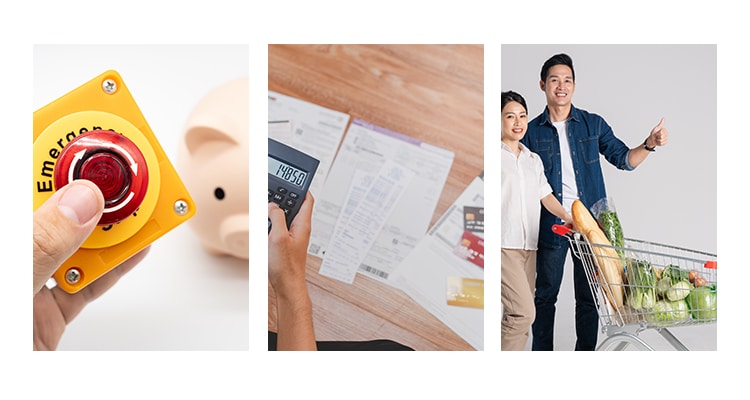Many of us see debt as a bad thing.
However, this isn’t always true.
Yes, poor debt management leads to financial ruin. Having multiple debts forces us to spend most of our income paying them instead of putting it towards basic necessities or an emergency fund.
That said, when well-managed and used for the right purpose, debt can help us build our wealth.
Knowing the difference between good and bad debt helps you make better decisions and improve your financial health.
To help you differentiate one from the other, here are the differences between good and bad debt and some examples of each.

What is Good Debt?
In a nutshell, good debt is any loan that helps you achieve your financial goals. These are seen as investments and help you either generate income in the long run or build your credit score.
Additionally, good debt usually has lower interest rates than bad ones, making it easier to pay over time.
Examples of Good Debt
Here are some common examples of what good debt looks like:
Mortgages
Mortgages allow you to invest in real estate, which has the potential to grow in value over time. This gives homeowners a significant return on investment when they sell or lease their property.
Paying off your mortgage also builds your equity, giving you the potential for tax breaks unavailable to renters.
Aside from these, investing a property provides a sense of security and stability, especially now that rental costs are increasing.
Student Loans
Our parents always told us that a good education is vital for a better future.
However, quality education isn’t cheap, and many have to take student loans to be able to attend good universities and/or take post-graduate studies.
Student loans are typically considered good debt since they represent an investment in yourself and your future. Having a degree or doctorate can lead to higher earning potential and access to better job opportunities on the whole.
Business Loans
Like student loans, borrowing money to start a business or expand one can lead to more income and growth over time.
However, before taking out a business loan, carefully weigh the risks of starting a business.
If you’re not careful, this loan can backfire and land you in financial trouble.

What is Bad Debt?
The main difference between good and bad debt is that the latter worsens your financial health.
Bad debt offers no long-term benefit and often comes with high interest rates or unfavorable repayment terms.
Additionally, incurring several bad debts negatively affects your credit score, making it more difficult to obtain loans in the future.
Note that even good debts can become bad, depending on your circumstances.
For example, let’s say you suddenly lost your work from home job before you’ve paid off a mortgage loan. Unless you can quickly find a new job, you won’t have the means to pay it off anymore.
Examples of Bad Debt
Here are some examples of bad debt you should avoid:
Unchecked Credit Card Debt
A common pitfall for many credit card users is spending more than what they can afford to pay.
A new TV here. A new smartphone there. Don’t forget that upcoming trip to Boracay next month.
All these accumulate over time, and when you can’t pay them all, it leads to high interest debts.
Not only are these difficult to pay off, but the value of these purchases decreases over time. Thus, when you try to re-sell these items in the future, you’ll only regain a fraction of the amount you originally paid for them.
Payday Loans
If credit card loans are bad, payday loans are worse.
Payday loans are short-term loans with a high interest rate that the borrower will repay upon receiving their next paycheck.
These loans are often considered predatory lending due to their high interest rates and hidden fees, trapping borrowers in a cycle of debt.
Car Loans
Wait, isn’t getting a car smart since you no longer have to spend so much time and money commuting? Well, yes and no.
If you need a car for work or to take your kids to school, getting a car loan can be a smart investment.
However, if you’re planning to get a car just as a status symbol, a car loan will be a bad debt. Additionally, a car’s value depreciates over time – unless it’s a collectible.
If you must take a car loan, choose an economical model over a luxury one.

How to Avoid Bad Debt
Here are some tips that can help you avoid acquiring bad debts:
Calculate and Review Your Monthly Payments
Before signing up for a loan, always consider if you can afford to pay them back on time in the first place.
Factor in the loan’s interest rate, payment options, and your current financial standing before agreeing to it.
That way, you can prepare your budget to accommodate this expense and avoid overcommitment.
Live Within Your Means
Taking out a big loan is a significant financial decision.
Before you do so, ask yourself: “Is this expense really work taking a loan out for? Do I really need it urgently?”
Differentiating between your needs and wants helps avoid unnecessary purchases and in turn, bad debts.
If you really want something that isn’t an urgent need, you can save up for it instead of taking out a loan for it. Or, you can wait for its price to go down and then purchase it when it’s more affordable.
Build an Emergency Fund
A common reason why Filipinos take out loans is unforeseen emergency expenses like medical bills, car repairs, or sudden job loss.
The best way to avoid this is by setting aside a portion of your income, no matter how small, just for these emergencies. In other words, build an emergency fund.
Having one helps you avoid taking on loans or debts when emergencies arise – and gives you peace of mind.

Know the Right Types of Debt for Financial Success
Many Filipinos see debt as a financial burden, yet another expense they need to pay for each week or month.
However, not all types of debt are detrimental to your financial health.
Knowing the difference between good and bad debt can help you avoid financial pitfalls and grow your wealth.
Still, one of the best ways to achieve financial stability is having a full-time work from home job. This gives you a relatively stable source of income while cutting down on expenses like commuting or going out to eat.
If you’re looking for an online work from home setup, Remote Staff is here to help.
Our jobs list contains various available positions, ranging from online transcription jobs to online design jobs.
Ready to build financial freedom through an online career? Sign up here. Good luck!

